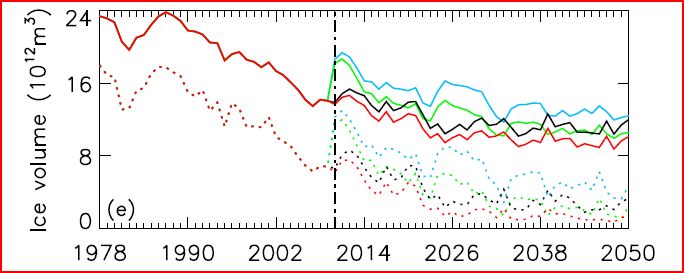I think you can exempt calving pretty easily. During summer MODIS (or similar in the future) could easily be used for that purpose. Failing that, with a seriously thinned ice pack, large bergs would stand out on an EM flight over the CAA Arctic coast (I think).
Calving isn't the issue.
For as long as there is ice over winter there will be compaction against the CAA. The PIOMAS thinning experiment isn't realistic in that respect as the ice was thinned in early summer. However thinner ice is more easily ridged and transported by the wind, so the compaction against the CAA will produce ice that is thicker than the majority of the pack, whatever the thickness of the bulk of the pack. I am not convinced it will be easy to remove that ice totally. I suspect that not only will substantial winter warming be needed to get it thin enough to melt late season (as the rest of the pack has to melt out to allow the ice edge to get near it), but substantial ocean warming will also be needed.
I can post graphs if needed but the greatest source of heating is in the autumn, and that is heat venting from open water warmed during the summer. So using trends of annual average temperature to get a handle on future prospects is flawed because a large part of the annual warming is due to a heat loss process. Summer warming is pegged low because of all the melting ice, spring warming would be highly relevant, winter warming is to a lesser degree than autumn contaminated by the heat loss signature. It's hard to get a handle on how winter thermodynamic thickening will be affected by future warming. Yes it will go down, but how fast.
To examine the difficulties involved I want to use the relative robustness of the PIOMAS rate of change plot I've done, robust that is in the face of the changes seen since 1978. What it shows (peaking of volume loss rate around the solstice) is the dominance of the sun in the seasonal cycle.

Taking the rate of loss from the transition from gain to loss of volume in April I can accumulate the tend day increments of volume. Using the post 2007 period the cumulative sum of volume loss is 18.1k km^3. That's the amount of ice melted by available solar radiation. Therefore to get zero ice in theory you'd need a winter peak volume of about 18k km^3. That volume corresponds to a thickness of about 1.9m average for the whole pack (assuming an area of around 9.65M km^2), i.e. say 1.5m around the peripheral seas and maybe 2 to 3m thick off the CAA.
That doesn't sound a lot to lose. But the PIOMAS thinning experiment tells us that all is not well with this reasoning, because in PIOMAS there is still a substantial residual of ice even when the pack has thinned by 1m early in the season (from current levels that's a pack thickness of a bit over 1m thick average for the pack away from the CAA).
What I presume is going on is that the extra energy that would have gone into melting ice then goes into warming the ocean, but much of this is then vented to the atmosphere in autumn. During the summer there is no strong mechanism to mix this warmed water effectively with the remnant ice pack off the CAA, storms mix laterally but they also mix vertically in the water column, reducing the temperature of the warm surface water and thus reducing the effect on the ice (heat flux into the ice that melts ice depending on temperature difference between ice and water).
The whole matter is so complex I think only physical modelling can get a handle on it. And we've all seen by now the results of the study that used PIOMAS to project into the future.

Even I don't think winter ice will stay so level for so long (2026 to 2050), but add in the effect of ridging and ice piling up against the CAA and I can't see how we'll have a
totally ice free Arctic Ocean much before the middle of the Century.
